Ah, summer. Long relaxing days spent at the lake, just swimming, fishing, and enjoying the scenery. Think you can only enjoy lakes here on Earth? Well, think again. NASA’s Cassini spacecraft might have turned up a lake on Titan, Saturn’s largest moon. It might not be the kind of lake you’re used to though. The average temperature on Titan is only a hundred degrees above Absolute Zero, so it’s probably a lake of liquid hydrocarbons. Carolyn Porco is the leader on the imaging team on the Cassini mission to Saturn and the director for the Center of Imaging Operations at the Space Science Institute in Boulder, Colorado. That’s where the images from Cassini are processed and released to the public.
Continue reading “Podcast: Summer at the Lake… on Titan”
Audio: Summer at the Lake… on Titan
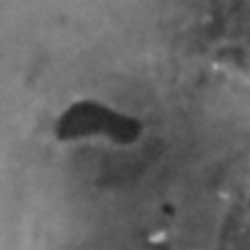
Possible lake on Titan. Image credit: NASA/JPL/SSI. Click to enlarge.
Listen to the interview: Summer at the Lake… on Titan (6 MB)
Or subscribe to the Podcast: universetoday.com/audio.xml
Fraser Cain: Let’s say I’m standing on the surface of Titan beside this feature, what would I be seeing?
Carolyn Porco: Well, we’re not absolutely sure, but if it is, in fact, a lake of hydrocarbons, then you would see something that would look rather dark. It may have some materials disolved in it and perhaps waves would be lapping up at the shore which would of course be ice, water ice. Mind you, it’s incredibly cold. Overall, the scene would be very dark because high noon on Titan is like deep Earth twilight, and it might even be possibly raining methane because this feature has been found in the place on Titan where there seems to be the most clouds and therefore the greatest likelihood of rain. Not that Titan is a very cloudy place, mind you. We haven’t seen many clouds on Titan. Where we’ve seen clouds is mostly in the south polar region where this feature the size of Lake Ontario has been found.
Fraser: Now I know that images of Titan taken by Voyager and other telescopes show it as a very smoggy, cloudy world. So, how can we see the lake?
Porco: There’s a difference between smog, haze and then clouds. Clouds are particulates of some condensable material; it could be liquid droplets or the fact is if they’re high enough they could be solid particles. On the Earth, cirrus clouds are made of water ice, unlike your normal cumulous clouds that rain on you; they rain liquid water. So we could have a similar thing going on Titan, except the material, of course, is methane. But as I said, there aren’t many clouds. It’s not clouds which are making the surface of Titan so difficult to see from high above. It’s haze particles – these are haze particles, like smog particles on Earth – probably made, almost certainly made, of hydrocarbon materials, polymers probably, of carbons all linked together. These are very small particles, but the atmosphere is very very thick; hundreds of kilometres thick with this stuff. If you’re standing on the surface, you can, of course, see the surface and see even to the horizon, and a bit through it. Mind you, recall what the images taken by the Huygens probe looked like. We could see to the horizon, once the probe was on the surface and took pictures, we could see to the horizon. But if you look up through the very thick atmosphere, or if you’re above looking down, then your path through this thick atmosphere filled with haze is so long, that it’s difficult for visible light to get through. And of course, we see with visible light. In images taken with Voyager, and Voyager had a camera that could look only to the long end of where humans see with their eyes; in fact, a little beyond where we see with our eyes. But nonetheless, not far enough to see down to the surface of Titan. But with the Cassini cameras, we have used a trick that was discovered basically by ground-based astronomers. If you go to the longer wavelengths in the electromagnetic spectrum, you go into the near-infrared, you can in fact see down to the surface of Titan. Those are the wavelengths that we have used to image the surface of Titan with our cameras, and of course, it is in those wavelengths that we discovered this lakelike feature on the surface.
Fraser: Now, if it isn’t a lake of liquid hydrocarbon, what else could it be?
Porco: Well, we’re not completely sure, 100% sure, that it’s filled with liquid. Perhaps it was a depression that once was filled with liquid, and all the liquid has since evaporated, and we’re now seeing the residue of what was left behind. So it could be solid hydrocarbons that still would form a flat surface. You could imagine a salt lake bed on the Earth; the salt having been left behind after the water evaporated. So we could be seeing something that is just solid material. That’s the two basic possiblities: it could be solid material or it could be liquid. We won’t know for sure whether or not it’s liquid until we have the opportunity to see a reflection of the Sun in the surface of this body; a specular reflection, or mirror like reflection like you can see if you’re flying in an airplane over Minnesota for example. Looking down on the ground and it’s daylight, you can see specular reflections; you can see the image of the Sun glinting off the surface of all the many lakes that dot the landscape of Minnesota.
Fraser: That’s incredible, you’ll be able to see that?
Porco: We won’t be able to see that with our cameras, probably, because the geometry won’t allow us to. The solar illumination geometry and the fact that, at the wavelengths that even the Cassini cameras can see, if we look through too long a path length in the atmosphere, things get very hazy and fuzzy, and we don’t get a clear view of the surface. However, there are other instruments on Cassini that work at longer wavelengths than we do, and they go further into the near infrared. They have an easier time seeing down to the surface, and it’s possible – we have to check the upcoming encounters with Titan. So this is not a certainty yet, but at least in principle it’s possible that they could see a mirror like reflection off the surface of this body, if in fact it’s liquid. The jury is still out on this, and we may be lucky to have the kind of circumstances on future flybys of Titan to catch whether or not it’s truly liquid.
Fraser: When will Cassini have a chance to revisit the area?
Porco: I’m not quite certain of that. There are people on my team who are busy planning the Titan flybys; planning the imaging sequences for each of the upcoming Titan flybys would know that better than I do. But I think it may not be until later on in the tour when we really have a good look again at this feature. As I’ve said many times, it’s going to take us years to work out what’s truly going on on the surface of Titan. We come by it many times during the course of this mission, which ends nominally in the middle of 2008. If we’re lucky enough, and the American Congress is willing, we’ll get an extension, and we could be observing bodies in the Saturn system for the next decade. But right now we have something like 39 further encounters with Titan.
Fraser: And if it does turn out to be liquid hydrocarbon, what does that tell you about Titan’s geology or its history?
Porco: It tells that at least in part, the thinking that we had about the methane cycle on Titan, and the amount of methane in the atmosphere is correct. Because there had been predictions that the surface of Titan would have some liquids on the surface. And we haven’t seen as many as some of the models had predicted, but if there is any at all, that gives a source of the methane that’s in the atmosphere, if there’s some liquid on the surface. Of course, the next question is: how did that amount of methane get into the atmosphere to begin with? Did it come from volcanoes, or did it come from some other source? The question of how methane can even exist right now on the surface of Titan, when we know it’s being broken up in the upper atmosphere. But still, it confirms for us, at least in part, some of our thinking about what is going on between the surface and the atmosphere, and that’s interesting to know. This is another atmosphere, in many ways similar to our Earth. It gives us another example to study in learning about our own atmosphere. Bear in mind that Titan also has a kind of mild greenhouse effect going on. It’s surface temperature is 12-degrees Kelvin greater than it would be otherwise, if there were no methane in its atmosphere. So, we stand to learn a lot about our own planet, and what makes our own planet unique, and what makes it have anything in common at all with some other body, like Titan, by studying Saturn’s largest moon.
Fraser: Have you imaged Titan well enough now to know that this is the only feature like this on the planet?
Porco: Oh, not by a long shot. We’re just beginning here. These are early days. I don’t know what percentage of the surface has been covered yet, but it’s still a small fraction at the kind of resolution that we would need to see these kinds of features. So no, we have a long way to go, and I think there’s going to be a lot more exciting discoveries in store, so stay tuned is the message really.
Astrophoto: Conjunction from South Australia
Many photographers sent in their images of the recent planetary conjunction of Venus, Mercury and Saturn. Here’s a picture taken by Glenn James from Barossa Valley in South Australia.
Do you have photos you’d like to share? Post them to the Universe Today astrophotography forum or email them to me directly, and I might feature one in Universe Today.
Deep Impact Made a Bright Flash
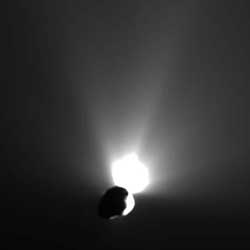
The brilliant flash of light created by Deep Impact as it smashed into Tempel 1. Image credit: NASA/JPL. Click to enlarge.
The hyper-speed demise of NASA’s Deep Impact probe generated an immense flash of light, which provided an excellent light source for the two cameras on the Deep Impact mothership. Deep Impact scientists theorize the 820-pound impactor vaporized deep below the comet’s surface when the two collided at 1:52 am July 4, at a speed of about 10 kilometers per second (6.3 miles per second or 23,000 miles per hour).
“You can not help but get a big flash when objects meet at 23,000 miles per hour,” said Deep Impact co-investigator Dr. Pete Schultz of Brown University, Providence, R.I. “The heat produced by impact was at least several thousand degrees Kelvin and at that extreme temperature just about any material begins to glow. Essentially, we generated our own incandescent photo flash for less than a second.”
“They say a picture can speak a thousand words,” said Deep Impact Project Manager Rick Grammier of NASA’s Jet Propulsion Laboratory, Pasadena, Calif. “But when you take a look at some of the ones we captured in the early morning hours of July 4, 2005 I think you can write a whole encyclopedia.”
At a news conference held later on July 4, Deep Impact team members displayed a movie depicting the final moments of the impactor’s life. The final image from the impactor was transmitted from the short-lived probe three seconds before it met its fiery end.
“The final image was taken from a distance of about 30 kilometers (18.6 miles) from the comet’s surface,” said Deep Impact Principal Investigator Dr. Michael A’Hearn of the University of Maryland, College Park. “From that close distance we can resolve features on the surface that are less than 4 meters (about 13 feet) across. When I signed on for this mission I wanted to get a close-up look at a comet, but this is ridiculous? in a great way.”
The Deep Impact scientists are not the only ones taking a close look at their collected data. The mission’s flight controller team is analyzing the impactor’s final hours of flight. When the real-time telemetry came in after the impactor’s first rocket firing, it showed the impactor moving away from the comet’s path.
“It is fair to say we were monitoring the flight path of the impactor pretty closely,” said Deep Impact navigator Shyam Bhaskaran of JPL. “Due to the flight software program, this initial maneuver moved us seven kilometers off course. This was not unexpected but at the same time not something we hoped to see. But then the second and third maneuvers put us right where we wanted to be.”
The Deep Impact mission was implemented to provide a glimpse beneath the surface of a comet, where material from the solar system’s formation remains relatively unchanged. Mission scientists hoped the project would answer basic questions about how the solar system formed, by providing an in-depth picture of the nature and composition of the frozen celestial travelers known as comets. The University of Maryland is responsible for overall Deep Impact mission science, and project management is handled by JPL. The spacecraft was built for NASA by Ball Aerospace & Technologies Corporation, Boulder, Colo.
For information about Deep Impact on the Internet, visit http://www.nasa.gov/deepimpact.
Original Source: NASA News Release
Book Review: Big Bang: The Origin of the Universe

I’ll declare this right from the start, Simon Singh is one of my favorite science writers. His two previous books, Fermat’s Enigma and The Code Book are excellent. Especially the Code Book, which I was a little nervous to read, but walked away with a very firm understanding of codes and codebreaking through the centuries.
With Big Bang, Singh starts right at the beginning of cosmology, as the ancient Greeks showed a surprising series of leaps of logic about the Solar System. They correctly understood that the Earth is a sphere, and estimated its size. They calculated the distance to the Moon, and even took a stab at guessing the distance to the Sun. Unfortunately, they developed an incorrect view of an Earth-centred Universe, where the Sun, stars and the planets orbit the Earth. As errors developed in their theory, the Earth-centred astronomers just made their model more complex to compensate.
The book goes on to present discoveries in cosmology, one after the other, from the Copernicus Sun-centred view to Edwin Hubble’s discovery that many distant “nebulae” are actually other galaxies, like our Milky Way. Hubble then went on to discover that these distant galaxies are actually speeding away from us. It’s this discovery, that our Universe is expanding, which led to the theory we now call the Big Bang.
The Big Bang is such a profound theory, and it’s even more amazing because it’s embraced by nearly everyone working in cosmology today. Thank the evidence for this. Singh tracks down each piece of evidence supporting the Big Bang: the abundance of hydrogen in the Universe, the discovery that galaxies are speeding away from us, and the cosmic microwave background radiation. He introduces the reader to the cast of characters involved in each discovery, and then leads us through the observations and breakthroughs that formed this piece of evidence. We also meet the challengers and understand their differing, and very valid, viewpoints.
While reading Big Bang, you get the sense the Singh wanted to get across how well supported a theory the Big Bang is. This isn’t some half-baked theory about the Universe; the cosmologists who developed the Big Bang made some dramatic predictions which have turned out to be supported by observation. Some of the most dramatic are the most recent, with the Wilkinson Microwave Anisotropy Probe, which mapped variations in the microwave background radiation with such exquisite detail to help explain variations of matter in the Universe – why there are clumps of matter, like galaxies, planets, and people, and not just a rapidly spreading mist of equally-spaced hydrogen.
As I was reading Big Bang, through, I kept noticing how quickly I was moving through the book, and how slowly the story was progressing. Not that I was bored, but I was amazed at how long it took for discoveries to be presented. Once there was only a sliver remaining, I realized that I had slightly misjudged what the book was going to be about. Singh essentially wraps up with the discovery of the cosmic microwave background radiation by Penzias and Wilson – case closed, that’s the story of the Big Bang.
I follow astronomy and cosmology on a daily basis, and I know the story isn’t over. There are many intriguing discoveries being made all the time, such as dark energy, dark matter, and inflationary cosmology. Singh gives each of these subjects little more than a sentence or two in an epilogue, and this is unfortunate. I would have liked to see him tackle these fascinating subjects with the same care and skill that he handled the rest of the book. Perhaps a sequel Simon?
If you’re interested in astronomy, and want to get a nice overview of the Big Bang, I highly recommend this book by Simon Singh. It’s easy to read and understand, and gives a great overview of the theory, the theorists, and the evidence.
Read more reviews or order a copy online from Amazon.com
Review by Fraser Cain
Deep Impact Smashes Into Tempel 1
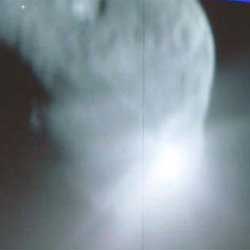
View of the material ejected from Tempel 1. Image credit: NASA/JPL.
After 172 days and 431 million kilometers (268 million miles) of deep space stalking, Deep Impact successfully reached out and touched comet Tempel 1. The collision between the coffee table-sized impactor and city-sized comet occurred at 1:52 a.m. EDT.
“What a way to kick off America’s Independence Day,” said Deep Impact Project Manager Rick Grammier of NASA’s Jet Propulsion Laboratory, Pasadena, Calif. “The challenges of this mission and teamwork that went into making it a success, should make all of us very proud.”
“This mission is truly a smashing success,” said Andy Dantzler, director of NASA’s Solar System Division. “Tomorrow and in the days ahead we will know a lot more about the origins of our solar system.”
Official word of the impact came 5 minutes after impact. At 1:57 a.m. EDT, an image from the spacecraft’s medium resolution camera downlinked to the computer screens of the mission’s science team showed the tell-tale signs of a high-speed impact.
“The image clearly shows a spectacular impact,” said Deep Impact principal investigator Dr. Michael A’Hearn of the University of Maryland, College Park. “With this much data we have a long night ahead of us, but that is what we were hoping for. There is so much here it is difficult to know where to begin.”
The celestial collision and ensuing data collection by the nearby Deep Impact mothership was the climax of a very active 24 hour period for the mission which began with impactor release at 2:07 a.m. EDT on July 3. Deep space maneuvers by the flyby, final checkout of both spacecraft and comet imaging took up most of the next 22 hours. Then, the impactor got down to its last two hours of life.
“The impactor kicked into its autonomous navigation mode right on time,” said Deep Impact navigator Shyam Bhaskaran, of JPL. “Our preliminary analysis indicates the three impactor targeting maneuvers occurred on time at 90, 35 and 12.5 minutes before impact.”
At the moment the impactor was vaporizing itself in its 10 kilometers per second (6.3 miles per second) collision with comet Tempel 1, the Deep Impact flyby spacecraft was monitoring events from nearby. For the following14 minutes the flyby collected and downlinked data as the comet loomed ever closer. Then, as expected at 2:05 a.m. EDT, the flyby stopped collecting data and entered a defensive posture called shield mode where its dust shields protect the spacecraft’s vital components during its closest passage through the comet’s inner coma. Shield mode ended at 2:32 a.m. EDT when mission control re-established the link with the flyby spacecraft.
“The flyby surviving closest approach and shield mode has put the cap on an outstanding day,” said Grammier. “Soon, we will begin the process of downlinking all the encounter information in one batch and hand it to the science team.”
The goal of the Deep Impact mission is to provide a glimpse beneath the surface of a comet, where material from the solar system’s formation remains relatively unchanged. Mission scientists expect the project will answer basic questions about the formation of the solar system, by offering a better look at the nature and composition of the frozen celestial travelers known as comets.
The University of Maryland is responsible for overall Deep Impact mission science, and project management is handled by JPL. The spacecraft was built for NASA by Ball Aerospace & Technologies Corporation, Boulder, Colo.
For information about Deep Impact on the Internet, visit http://www.nasa.gov/deepimpact.
Original Source: NASA/JPL News Release
Book Review: Conflict in the Cosmos, Fred Hoyle’s Life in Science
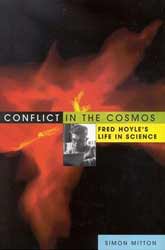
Fred Hoyle climbed through the challenges of Britain during the inter-war years. His diligence to his primary schooling was poor to say the least. Playing hookey was the order of his day. However, fortune smiled on him. Through this and his own effort, he managed to achieve a number of scholarships that kept him advancing until he gained acceptance into Cambridge University. There followed a checkered career as he studied mathematics with special application to nuclear physics. He had a short diversion due to the second world war where he advanced the state of electronic warfare. After, he jumped into the field of astronomy with both feet. During the remainder of his life, Fred Hoyle advanced this field and contributed to many others, often as not, by leading the explorations.
Leading any field is a balancing act between divining the future and keeping up with current events. Here emotion comes to the fore and here is where Mitton concentrates his book. He shows how Fred Hoyle, being in theoretical astronomy, often came to grips with observational astronomers. Further, Mitton builds a feeling that Fred Hoyle was like a kettle constantly steaming. Continual requests for publication were countered by people not understanding, or believing or wanting his views presented. Apparently, during most of his career, Fred Hoyle was at odds with the Royal Astronomical Society even though he was a member for most of his life. As well, Mitton shows how he appears to have used the largess of Cambridge to pursue his own work. In particular, he was a mentor who was seldom present. When he was, he was so caught up in his own theories, he didn’t always give the attention graduate students deserved. The resulting picture is of a vibrant, thoughtful, and analytical mathematician at the top of his game.
Mitton’s biography includes a mix of both personal and technical aspects to Fred Hoyle’s life. We read of Friday lunches in dimly lit rooms little better than cloisters. Further along there are recounts to a remarkable passion for hiking. He achieved the Munro, a climbing of a collection of hills in Scotland over 914 metres. He drove fast cars, enjoyed conferences by the lakes in Northern Italy and championed a telescope in Australia. Mitton relies on Fred Hoyle’s own autobiography as well as many friends and acquaintances to ensure accuracy and detail in the recollections.
On the technical side, Mitton details contribution to radar such as the bending of beams along the curvature of the Earth. Nucleosynthesis, one of the main focuses of Fred Hoyle’s career, gets a detailed and historical recount. Added are accounts of collaborations with experts as well as competitions against others. Mitton presents the information in a smooth, qualitative manner so there is no worry of confusion. All in all, Mitton builds an excellent link between the people, their discoveries and knowledge of the day that is both enjoyable to read and enlightening in its own way.
The interesting mix of personalities and technical information works well. Chapters are loosely divided chronologically. However, as Fred Hoyle had his finger into so many pies, Mitton decided to collect information into subject areas and deal with them chronologically. Due to this, there is a fair amount of jumping around in time throughout the text. This isn’t unduly bothersome but the reader must stay aware. Given the details on radar, advanced cosmology, science fiction novels, movie scripting, and leading an international collaboration on siting and building an observatory, this book is more of an insight into Fred Hoyle’s technical contributions than his personality.
Fred Hoyle’s emotions drove him to advance our understanding of cosmology. His work as a theoretical astronomer and science communicator captured the imaginations of people. Simon Mitton in his biography Conflict in the Cosmos, Fred Hoyle’s Life in Science brings back the life of Fred Hoyle, including the people and some of the technical issues of a person at the top of their game. Emotions are free to everyone, perhaps reading this will entice you on your own search for understanding.
Read more reviews, or order copy online from Amazon.com.
Review by Mark Mortimer
Largest Core in an Extrasolar Planet
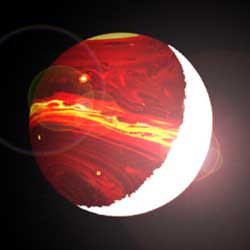
Artist illustration of the planet orbiting the sun-like star HD 149026. Image credit: U.C. Santa Cruz. Click to enlarge.
NASA researchers recently discovered the largest solid core ever found in an extrasolar planet, and their discovery confirms a planet formation theory.
“For theorists, the discovery of a planet with such a large core is as important as the discovery of the first extrasolar planet around the star 51 Pegasi in 1995,” said Shigeru Ida, theorist from the Tokyo Institute of Technology, Japan.
When a consortium of American, Japanese and Chilean astronomers first looked at this planet, they expected one similar to Jupiter. “None of our models predicted that nature could make a planet like the one we are studying,” said Bun’ei Sato, consortium member and postdoctoral fellow at Okayama Astrophysical Observatory, Japan.
Scientists have rarely had opportunities like this to collect such solid evidence about planet formation. More than 150 extrasolar planets have been discovered by observing changes in the speed of a star, as it moves toward and away from Earth. The changes in speed are caused by the gravitational pull of planets.
This planet also passes in front of its star and dims the starlight. “When that happens, we are able to calculate the physical size of the planet, whether it has a solid core, and even what its atmosphere is like,” said Debra Fischer. She is consortium team leader and professor of astronomy at San Francisco State University, Calif.
The planet, orbiting the sun-like star HD 149026, is roughly equal in mass to Saturn, but it is significantly smaller in diameter. It takes just 2.87 days to circle its star, and the upper atmosphere temperature is approximately 2,000 degrees Fahrenheit. Modeling of the planet’s structure shows it has a solid core approximately 70 times Earth’s mass.
This is the first observational evidence that proves the “core accretion” theory about how planets are formed. Scientists have two competing but viable theories about planet formation.
In the “gravitational instability” theory, planets form during a rapid collapse of a dense cloud. With the “core accretion” theory, planets start as small rock-ice cores that grow as they gravitationally acquire additional mass. Scientists believe the large, rocky core of this planet could not have formed by cloud collapse. They think it must have grown a core first, and then acquired gas.
“This is a confirmation of the core accretion theory for planet formation and evidence that planets of this kind should exist in abundance,” said Greg Henry, an astronomer at Tennessee State University, Nashville. He detected the dimming of the star by the planet with his robotic telescopes at Fairborn Observatory in Mount Hopkins, Arizona.
Original Source: NASA News Release
Hubble’s View of Deep Impact
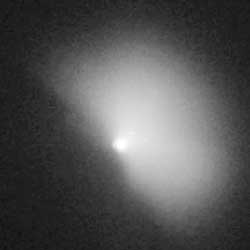
Hubble’s view of the Deep Impact collision. Image credit: Hubble. Click to enlarge.
The NASA/ESA Hubble Space Telescope captured the dramatic effects of the collision early on 4 July between the Deep Impact impactor spacecraft and Comet 9P/Tempel 1.
This sequence of images shows the comet before and after the impact. The image at left shows the comet just minutes before the impact. The encounter occurred at 07:52 CEST (05:52 UT/GMT).
In the middle image, captured 15 minutes after the collision, Tempel 1 appears four times brighter than in the pre-impact photograph.
Astronomers noticed that the inner cloud of dust and gas surrounding the comet’s nucleus increased by about 200 kilometres in size.
The impact caused a brilliant flash of light and a constant increase in the brightness of the inner cloud of dust and gas.
Hubble continued to monitor the comet, snapping another image (at right) 62 minutes after the encounter. In this photograph, the gas and dust ejected during the impact are expanding outward in the shape of a fan.
The fan-shaped debris is travelling at about 1800 kilometres an hour, or twice as fast as the speed of a commercial jet. The debris extends about 1800 kilometres from the nucleus.
The potato-shaped comet is 14 kilometres wide and 4 kilometres long. Tempel 1’s nucleus is too small even for the Hubble telescope to resolve.
The visible-light images were taken by the high-resolution camera on Advanced Camera for Surveys instrument. The Hubble Space Telescope is a project of international co-operation between ESA and NASA.
Original Source: ESA/Hubble News Release
What’s Up This Week – July 4 – July 10, 2005
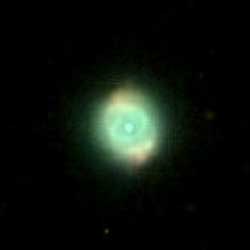
The “Cat’s Eye” Nebula. Image credit: Chris Deforeit at Astrim. Click to enlarge.
Monday, July 4 – 1054 A.D. This is the suspected date when Chinese astronomers noted the supernova from which we know the remnants of today as M1, the “Crab Nebula”. While this incredible event marks a red letter day in astronomy history, another is in the making.
If everything goes successfully, Deep Impact will have already been released and the information pouring in. For most of us, tonight will be our first chance to view, but for the lucky astronomers in the extreme western Americas – you’ve beat us to it! Just 3.5 degrees east/northeast of Spica, the comet is speculated to rise to 6th magnitude as the debris cloud spreads. No one knows exactly how long this will last, but viewers around the globe will get their opportunity to witness this event with a backyard telescope over the next 24 hours. Be there! I wish you all the very best of skies for this event.
So, if we can’t see a supernova remnant like the M1, or watch explosion happen on a comet, then what else can we do tonight? I’ve got a great idea – let’s check out the “Cat’s Eye” – it’s the best of both worlds! The proper designation is NGC 6543 and it’s located about midway between Delta and Zeta Draconis. As one of the most complex of all the planetary nebulae, it rose to popularity with the awesome Hubble photo. Very similar to the “Helix” nebula, our blue-green friend is the ejecta of a dying (possible double) star. This colorful planetary sends its light to us from roughly 3200 light years away and was the very first to be studied spectroscopically.
At magnitude 8.8, the “Cat’s Eye” can be spotted in large binoculars but will appear almost stellar. Smaller telescopes at high power will make it out as a slight disc, while larger scopes reveal the central star and far more color. For those with a nebular filter and a large scope, the NGC 6543 is a real pleasure to study as the helical area takes on form. Enjoy!
Tuesday, July 5 – Today as the date changes, the Earth reaches aphelion its farthest point from the Sun for the year while – oddly enough – Comet 9/P Tempel 1 reaches perihelion. So where’s the comet?
For northern hemisphere binocular users, look for the point of light visible to the southwest at twilight. That’s Jupiter. As the sky darkens completely, bright Spica will appear to Jupiter’s southeast. By aiming your binoculars there and placing Spica to the right of the field of view, you should be able to spot a faint fuzzy – the comet! For telescope users, Tempel 1 will appear almost directly between both star 68 and Gamma Virginis. Although we cannot perfectly predict what will happen after Deep Impact, studies suggest the comet will brighten to around 6th magnitude. Even if it doesn’t seem particularly impressive to smaller equipment, remember… You are viewing history! This will be the first time mankind has ever been able to make an effect on an astronomical object that can be viewed by the amateur.
If skies are cloudy tonight, keep trying. The effect of Deep Impact may last for days – or even weeks. The comet will continue to move south slowly over the next two weeks when it will be just west of Gamma Virginis.
Wednesday, July 6 – With some help from Edmond Halley, today in 1687 Sir Isaac Newton published his Principia with his three laws of motion. Since New Moon occurred in the early morning hours, this means dark skies tonight and an opportunity to study.
Normally, we’d go galaxy hunting on a dark night such as this, but how about if we explore the wonderful world of low power? Start by locating the magnificent M13 and move about 3 degrees northwest. What you will find is a splendid loose open cluster of stars known as Dolidze/Dzimselejsvili (DoDz) 5 – and it looks much like a miniature of the constellation of Hercules. Just slightly more than 4 degrees to its east and just about a degree south of Eta Hercules is DoDz 6, which contains a perfect diamond pattern and an asterism of brighter stars which resembles the constellation of Saggitta.
Now we’re going to move across the constellation of Hercules towards Lyra. East of the “keystone” you will see a tight configuration of three stars – Omicron, Nu and Xi. About the same distance that separates these stars to the northeast you will find DoDz 9. Using minimal magnification, you’ll see a pretty open cluster of around two dozen mixed magnitude stars that are quite attractive. Now look again at the “keystone” and identify Lambda and Delta to its south. About midway between them and slightly to the southeast you will discover the stellar field of DoDz 8. The last is easy – all you need to do is know beautiful red/green double, Ras Algethi (Alpha). Move about 1 degree to the northwest to discover the star-studded open cluster – DoDz 7. These great open clusters are very much off the beaten path and will add a new dimension to your large binocular, or low power telescoping experiences.
Thursday, July 7 – Are you ready for a visual challenge? Then see if you can spot the ultra-slim crescent of the Moon tonight. Less than a fist’s width above the horizon, look about 45 minutes after sunset as Selene begins its showing with the planets.
Tonight let’s try two more open star cluster studies that can be done easily with large binoculars or a low power scope. The first is a rich beauty that lays in the constellation of Vulpecula, but is easier found by moving around 3 degrees southeast of Beta Cygni. Known as Stock 1, this stellar swarm contains around 50 or so members of varying magnitudes that you will return to often. The next is an asterism known as the “Coat Hanger”, but it is also known as Brocchi’s Cluster, or Collinder 399. Let the colorful double star – Albeiro (which can be split in binos) – be your guide as you move about 4 degrees to its south/southwest. You will know this cluster when you see it, because it really does look like a coat hanger! Enjoy its red stars.
Friday, July 8 – What a way to start the weekend! As the skies darken to twilight tonight, be sure to check out the western horizon as the tender Moon has risen above our planetary pair of Venus and Mercury. Loaded with “earthshine”, this should be a picture perfect evening.
If skies are clear, let’s try some open star clusters in Cygnus. Starting with Gamma, identify loose open involving Gamma named Dolidze (Do) 43. Move two degrees southwest and pick up Do 42. Do not confuse it with nearby M29 – for the two look very similar. For fans of the “Double Cluster” in Perseus, you’ll like the next as we move another half degree to the southwest along the body of Cygnus to discover Do 40 and Do 41. This pretty pair of open clusters can be placed in the same lower power field. By moving another half degree due west, you’ll find highly populated Do 39 and it is a double treat as well – the brighter clump of stars in the same low power field is IC 4996.
Saturday, July 9 – Tonight the Moon will be less than half a fist’s width away from the “heart of Leo”, Regulus. While you may need binoculars to spot the star, be sure to note both it and Venus’ position and watch over the next two weeks as they draw closer.
Tonight after the Moon sets, take out your binoculars again to view two bright open clusters. The first, Ruprecht 173 is about a degree northwest of Epsilon Cygnii. You’ll appreciate this heavily populated star cluster! The next is as easy as identifying the constellation of Lyra. Just southeast of bright Vega is a wonderful double for binoculars, Delta 1 and 2 – the easternmost of the top two stars in the lyre. This bright pair is part of an open cluster known as Stephenson 1.
Sunday, July 10 – Tonight let’s enjoy a quiet evening of lunar contemplation. A wonderful crater to watch over the coming days lay on the western edge of Mare Crisium – Proculus. Tonight you will see it as a bright ring, but it will soon develop a ray system as the terminator moves west. Another beautiful pair of craters are near the terminator in the northern quandrant of the lunar orb – Atlas and Hercules. They are a splendid sight in binoculars and scope users can easily spot interior craterlets in these old giants.
Even if you only follow Deep Impact virtually, please watch this spectacular event. We’ll be on hand for history! May all your journeys be at Light Speed… ~Tammy Plotner
